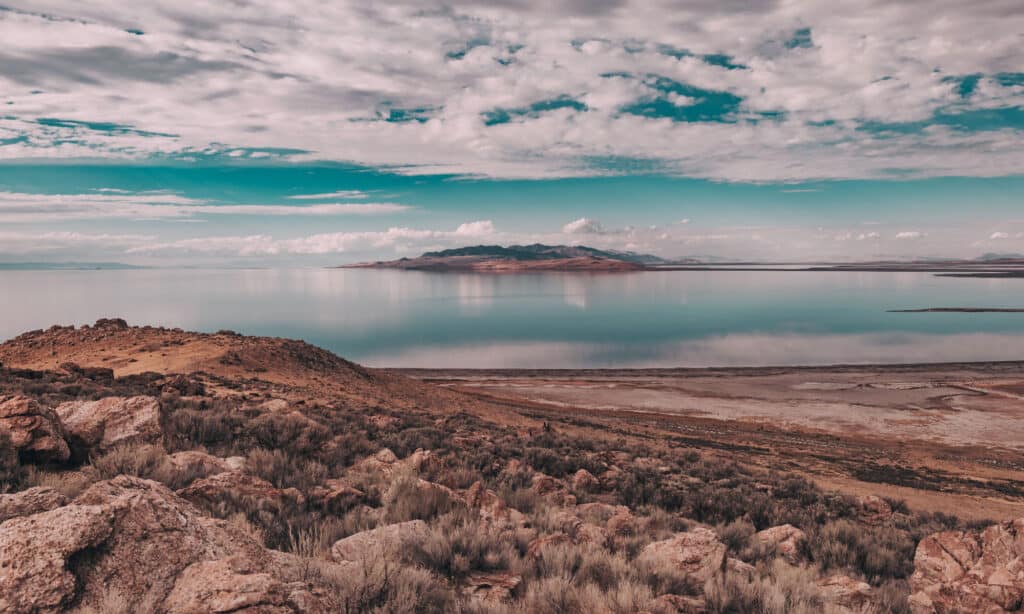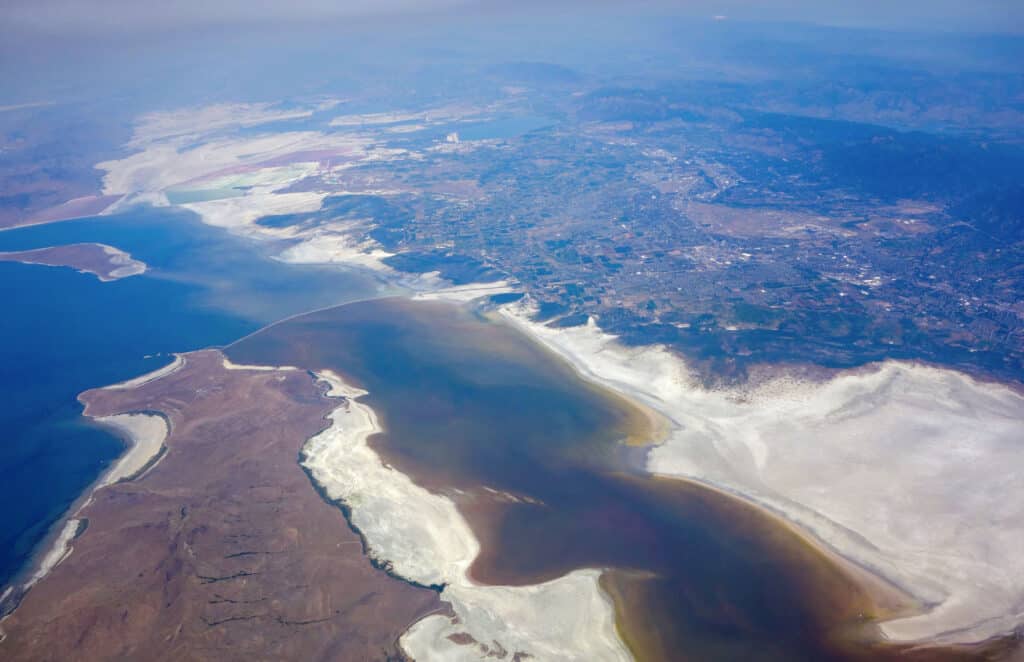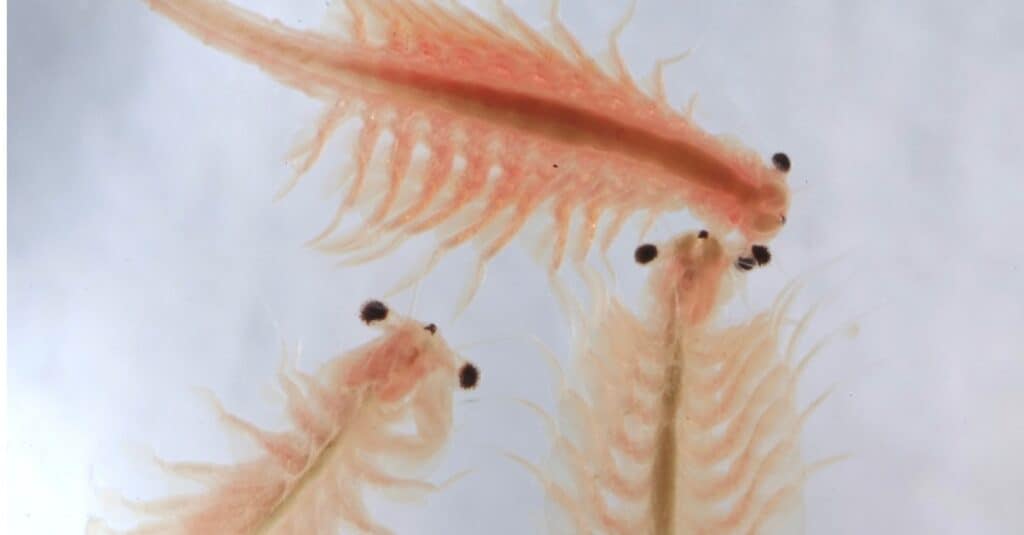
Great Salt Lake and its island provide unique scenery for the people of Utah and tourists.
This lake is known to be the remains of the ancient Lake Bonneville, which spanned about 20,000 square miles wide and was about ten times the current size of the Great Salt Lake. Great Salt Lake is considered one of the world’s largest hypersaline lakes and the 8th largest terminal lake.
This lake is divided into two sections: a highly saline northern arm and a moderately saline southern arm separated by semipermeable rocks. Great Salt lake has a surface area of 950 square miles (2,460 km²). But how deep is Utah’s Great Salt Lake? You’ll find out soon enough.
Why Is Great Salt Lake So Salty?

The salt level of Great Salt Lake is a result of a lack of an outlet for this lake.
©iStock.com/beccarie
Great Salt Lake got its name due to its incredibly high salinity and density. This lake is way saltier than seawater. Great Salt Lake accumulates about 1.1 million tons of minerals deposited to it yearly by its three tributary rivers: Jordan, Bear, and Weber.
The salt level of this water is caused by a lack of outlet in this lake, and it only escapes by evaporation, so the minerals accumulate and cause high salinity.
How Deep Is Great Salt Lake?

The highest average depth of the Great Salt Lake is 33 ft (10 meters).
©Bella Bender/Shutterstock.com
Great Salt lake has a surface area of 950 square miles (2,460 km²). Due to the rise and fall of its water level, this lake is measured to be about 16 feet (4.9 meters) deep. The highest average depth of this lake is 33 ft (10 meters), but it met its all-time high in 1987, at 45 ft (14m), and its low time depth of 4.19 ft in July 2022.
Why Is Great Salt Lake So Shallow?

The human consumption of the lake’s water significantly impacts how shallow the Great Salt Lake is.
©Thomas Barrat/Shutterstock.com
Great Salt lake’s shallow nature has been attributed to several reasons. The west desert pumping project is one reason. This project was developed to reduce flooding by pumping water into the nearest desert but has now resulted in the lake being shallow.
The human consumption of the lake’s water also significantly impacts how shallow the Great Salt Lake is. The current drought conditions and the overuse of snowmelt also contribute to Great Salt Lake’s shrinkage and shallowness. This reduces the lake’s water and makes it more shallow daily. In July 2022, the lake fell to its lowest point: an area of 950 square miles and an average depth of 4 ft.
Where Is the Great Salt Lake on a Map?
The Great Salt Lake is found towards the northern section of Utah and about 20 miles northwest of Salt Lake City going northwest on I-80. It is also about 550 miles west of Denver, Colorado.
Are There Fishes In Great Salt Lake?
Great Salt Lake is too saline to support most aquatic creatures. There are no fish in the Great Salt Lake. In years with high precipitation, some parts of the lake would incorporate enough fresh water to support some rare fish populations for a short period.
These fishes are Brine shrimp, cutthroat trout, common carp, least chub, rainbow trout, and rainwater killifish. Most of these fishes are washed in from nearby rivers and might grow in the lake sometimes. Meanwhile, they move out of the Great Salt Lake upon higher salinity and less fresh water. The fishes that come into the Great Salt Lake periodically are species from the lake’s tributaries.
Are There Animals In Great Salt Lake?
Great Salt Lake is considered America’s dead sea. Over time, the lake has become a habitat for both native and migratory birds and has now become a federally managed bird reserve. This lake is mainly home to algae, brine shrimps, and brine flies.
The brine flies rarely land on people, and they do not bite. Most birds that migrate to the lake use the brine flies for food. There might be a wide spread of birds around the lake, but they are no actual animals in the lake. More bacteria, algae, archaea, and protozoa exist in the water. The lake has the broadest population of Wilson’s phalarope species.
Swimming In Great Salt Lake
There are a lot of concerns about swimming in the Great Salt Lake. Ideas about the minerals in the lake being poisonous and life-threatening are one.
This lake’s high salt and density level is another primary concern for swimmers. When swimming in the Great Salt Lake, it is described as “feeling more like floating.” The smell of the lake and bugs might be a significant hassle.
Although most of these concerns are valid, you can enjoy a good swim in the Great Salt Lake. If you get to the southern part of the lake, the water flows in, and it is less smelly there. It is also less saline and more vegetative.
You should also get some water goggles and be ready to have a wash after, as swimming in the lake causes every part of your body to make contact with salt.
Is Great Salt Lake A Good Tourist Spot?
Great Salt Lake is considered the largest saltwater lake in the western hemisphere; therefore, it is a good tourist attraction. The lake holds beautiful scenery with several amazing birds.
You can also swim in the lake and experience a pleasant floaty feeling due to how dense the lake is. Finding fish in the lake is unusual, but it is not impossible. If you are a very patient fisherman, you will find a fish or two.
A tip to enjoying the Great Salt Lake is to visit the southern side of the river; this region has more life and vegetation. In addition, the lake city surrounds the Great Salt Lake and holds so many great views.
Great Salt Lake Park and Antelope Island State Park offer anatomic views of the lake and other tourist activities. Some resorts and stairs at the park provide accommodation and help elevate your overall holidaying experience at Great Salt Lake.
Do Animals Live in The Great Salt Lake?

The most well-known animal species that live in the Great Salt Lake are brine shrimp.
©iStock.com/Credit:S.Rohrlach
The Great Salt Lake is the largest saltwater lake in the Western Hemisphere and is located in Utah, USA. The lake has a unique ecosystem and is home to a variety of plant and animal species.
Let’s explore the question of whether animals live in the Great Salt Lake:
- Brine Shrimp: The most well-known animal species that live in the Great Salt Lake are brine shrimp. These tiny shrimp are found in the lake’s salty waters and are an important food source for many bird species, including the American avocet and Wilson’s phalarope. Brine shrimp are also commercially harvested and used as food for aquarium fish and shrimp.
- Brine Flies: Brine flies are another common animal species that live in the Great Salt Lake. These flies are adapted to living in the lake’s salty environment and are a food source for many bird species. The larvae of the brine flies are also an important food source for the brine shrimp.
- Algae: are also present in the Great Salt Lake and play an important role in the ecosystem. Algae are a food source for many animal species, including brine shrimp and brine flies. They also play a key role in maintaining the lake’s unique ecosystem.
- Waterfowl: such as pelicans, gulls, and ducks, are often seen around the Great Salt Lake. They come to the lake to feed on the brine shrimp and brine flies and also to nest in the lake’s marshes. The lake is an important breeding ground for many bird species.
- Insects: In addition to brine flies, there are other insect species that live in the Great Salt Lake area. These include beetles, grasshoppers, and spiders. These insects are an important food source for many bird species and other animals that live in the area.
To summarize, the Great Salt Lake is home to a variety of animal species, including brine shrimp, brine flies, algae, waterfowl, and insects.
The photo featured at the top of this post is © Abbie Warnock-Matthews/Shutterstock.com
Thank you for reading! Have some feedback for us? Contact the AZ Animals editorial team.






